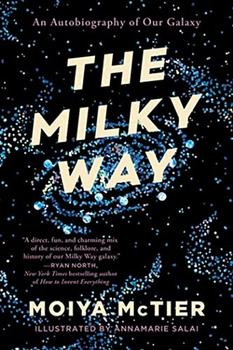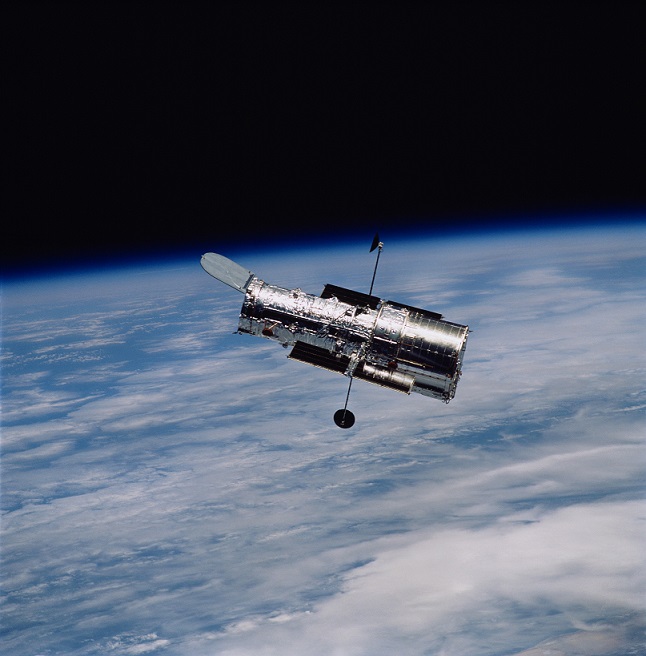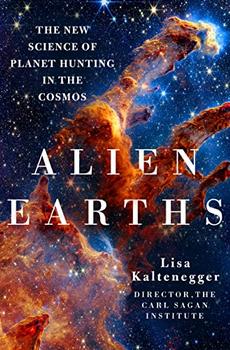Summary | Excerpt | Reviews | Beyond the Book | Read-Alikes | Genres & Themes | Author Bio

Critics' Opinion:
Readers' Opinion:
First Published:
Aug 2022, 256 pages
Paperback:
Aug 2023, 384 pages
 Book Reviewed by:
Book Reviewed by:
Erin Lyndal Martin
Buy This Book
This article relates to The Milky Way
 In The Milky Way: An Autobiography of Our Galaxy, Moiya McTier references the discoveries made by the Hubble telescope. NASA refers to the Hubble as "the most famous telescope," and the reasons are easy to see. For over 30 years, it has provided insights and never-before-seen imagery — and it's still evolving.
In The Milky Way: An Autobiography of Our Galaxy, Moiya McTier references the discoveries made by the Hubble telescope. NASA refers to the Hubble as "the most famous telescope," and the reasons are easy to see. For over 30 years, it has provided insights and never-before-seen imagery — and it's still evolving.
The telescope is named for Edwin Hubble, a groundbreaking American astronomer born just before the 20th century. Like the telescope that bears his name, Hubble had the mind and creativity to see what had been unknown. Namely, he proved that there are galaxies beyond the Milky Way and postulated that the universe expands at a constant rate.
The Hubble's origins go back to a 1943 paper by theoretical physicist Lyman Spitzer about the advantages of a space-based telescope. Spitzer was later made head of a design committee working out objectives for such a telescope that could be maintained in space. At the same time, noted astronomer Nancy Grace Roman (later called "the Mother of the Hubble") advocated for the Hubble's funding and became its project scientist. When NASA sought money from Congress in 1974, budget cutbacks meant there wasn't much support. Not to be dissuaded, astronomers lobbied and initiated letter-writing campaigns. By 1978, Congress had allocated $38 million to send the telescope (albeit a slightly smaller version than the original design) into space.
With a projected launch date of 1983, the construction of the telescope began in earnest. In addition to getting the mirror exactly right, the designers had to consider environmental obstacles like how quickly the sky would turn from light to dark. The team did multiple practice launches, which was necessary given that nothing like the Hubble had ever existed before, so they had no models to refer to. The telescope's launch was delayed due to the Challenger disaster; the pictures came back out of focus, requiring astronauts to install a specially designed device to correct a flaw in the main mirror, which was slightly out of shape — too flat by just 1/11000 inch. It was, on a larger scale, similar to providing a pair of glasses to correct a near-sighted person.
The telescope takes pictures with a digital camera, sending them back to earth via radio waves. It's a large and breathtakingly precise instrument all around. The Fine Guidance Sensors lock onto stars to control the movement and pointing of the craft. The telescope uses mirrors to reflect light because mirrors reflect all wavelengths. Servicing missions over time have upgraded the cameras and spectrometers to work better in dim or infrared light. In addition to taking pictures, the Hubble also has a spectrograph to analyze ultraviolet light to help determine how planets and galaxies were formed and how they've changed. It sends 140 GB of photos back to Earth every week — the colorful versions we see have been edited; the Hubble only takes photos in grayscale. Astronomers use filters to capture different wavelengths of light, then make a composite photo.
The Hubble is nothing if not a testament to the power of teamwork, ingenuity and persistence. Countless people have been involved in the decades it took to launch the telescope and in its upkeep since — thousands work on maintenance alone. Along the way, individuals have achieved their own accolades. In 1995, Robert Williams pointed the Hubble at total darkness for 10 days. It was risky, given that the expensive telescope might find nothing. Instead, the images captured distant galaxies never before known — what astronomers now call the Hubble Deep Field. Some of NASA's first female astronauts were involved in the project as well. Kathryn Sullivan details her time at NASA working on the telescope in a memoir titled Handprints on Hubble. In 2011, astronomer Adam Riess won the Nobel Prize for physics based on the Hubble's findings. Using its images, Riess was able to more accurately calculate the age of the universe. The Hubble has been measuring the shrinking Great Red Spot on Jupiter, and studying exoplanets and supermassive black holes. The Hubble also keeps an eye on other planets' weather, which helps us understand our own.
There are currently no more planned space maintenance journeys scheduled for Hubble, but the telescope is still operational and being maintained from the ground. Its legacy is evident in its successors, such as the Webb telescope, which launched in 2021.
Hubble telescope, courtesy of NASA
Filed under Medicine, Science and Tech
![]() This "beyond the book article" relates to The Milky Way. It originally ran in October 2022 and has been updated for the
August 2023 paperback edition.
Go to magazine.
This "beyond the book article" relates to The Milky Way. It originally ran in October 2022 and has been updated for the
August 2023 paperback edition.
Go to magazine.




In youth we run into difficulties. In old age difficulties run into us
Click Here to find out who said this, as well as discovering other famous literary quotes!
Your guide toexceptional books
BookBrowse seeks out and recommends the best in contemporary fiction and nonfiction—books that not only engage and entertain but also deepen our understanding of ourselves and the world around us.